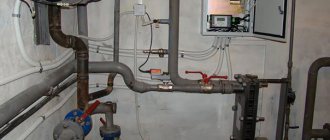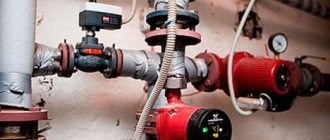An individual heating point is a whole complex of devices located in a separate room, including elements of thermal equipment. It ensures the connection of these installations to the heating network, their transformation, control of heat consumption modes, operability, distribution by type of coolant consumption and regulation of its parameters.
Order a heating point
A thermal installation engaged in servicing a building or its individual parts is an individual heating point , or abbreviated as ITP . It is designed to provide hot water supply, ventilation and heat to residential buildings, housing and communal services, as well as industrial complexes.
The individual heating point ensures the following tasks:
- Accounting for heat and coolant consumption.
- Protection of the heat supply system from emergency increases in coolant parameters.
- Disabling the heat consumption system.
- Uniform distribution of coolant throughout the heat consumption system.
- Adjustment and control of circulating fluid parameters.
- Converting the type of coolant.
Where are individual heating units made?
The production of BTP (block individual heating points) is located in the Moscow region, in the Odintsovo district, the village of Khlyupino.
The production of heating points is carried out at the production base. The company's central office is located in Moscow.
Production location on the map
Advantages of an individual heating point.
- High efficiency.
Long-term operation of an individual heating point has shown that modern equipment of this type, unlike other non-automated processes, consumes 30% less thermal energy.
Operating costs are reduced by approximately 40-60%.
Selecting the optimal heat consumption mode and precise adjustment will allow you to reduce thermal energy losses by up to 15%.
- Quiet operation.
- Compactness.
The overall dimensions of modern heating units are directly related to the heat load. When placed compactly, an individual heating point with a load of up to 2 Gcal/hour occupies an area of 25-30 m2.
Possibility of locating this device in small-sized basement rooms (both in existing and newly constructed buildings).
- The work process is fully automated.
To service this thermal equipment, highly qualified personnel are not required.
ITP (individual heating point) provides comfort in the room and guarantees effective energy saving.
The ability to set a mode based on the time of day, apply weekend and holiday modes, as well as carry out weather compensation.
- Individual production depending on customer requirements.
Find out about the additional benefits of heating points
Diagram of a heating point.
The classic ITP scheme includes the following nodes:
- Input of the heating network.
- Metering device.
- Connecting the ventilation system.
- Connecting the heating system.
- Hot water connection.
- Coordination of pressures between heat consumption and heat supply systems.
- Recharge of heating and ventilation systems connected according to an independent circuit.
Typical schemes of block heating points
When developing a heating point project, the required components are:
- Metering device.
- Pressure matching.
- Input of the heating network.
- The configuration with other components, as well as their number, is selected depending on the design solution.
"Olympus" Kazan
Thermal energy metering unit.
The basis of energy saving measures is the metering device. This accounting is required to perform calculations for the amount of thermal energy consumed between the heat supply company and the subscriber. Indeed, very often the calculated consumption is much higher than the actual one due to the fact that when calculating the load, heat energy suppliers overestimate their values, citing additional costs. Such situations will be avoided by installing metering devices.
Purpose of metering devices.
- Ensuring fair financial settlements between consumers and energy suppliers.
- Documentation of heating system parameters such as pressure, temperature and coolant flow.
- Control over the rational use of the energy system.
- Monitoring the hydraulic and thermal operating conditions of the heat consumption and heat supply system.
Classic scheme of metering devices.
- Thermal energy meter.
- Pressure gauge.
- Thermometer.
- Thermal converter in the return and supply pipelines.
- Primary flow transducer.
- Magnetic mesh filter.
Service.
- Connecting a reading device and then taking readings.
- Analyzing errors and finding out the reasons for their occurrence.
- Checking the integrity of seals.
- Analysis of results.
- Checking technological indicators, as well as comparing thermometer readings on the supply and return pipelines.
- Adding oil to the liners, cleaning the filters, checking the grounding contacts.
- Removing dirt and dust.
- Recommendations for the correct operation of internal heating networks.
Order a thermal energy metering unit UUTE
Consumption systems.
The standard layout of an individual heating point may have the following systems for providing thermal energy to consumers:
- Heating.
- Hot water supply.
- Heating and hot water supply.
- Heating, hot water supply and ventilation.
DHW module (hot water supply)
Schematic diagram of the hot water supply module
Equipment composition of the hot water supply module:
- ball valve "welded"
- flange strainer
- differential pressure regulator
- electric control valve
- Wafer check valve
- butterfly valve / ball valve
- flange strainer
- coupling drain valve
- temperature sensor
- collapsible heat exchanger
- electronic temperature controller
- circulation pump
- safety valve
- bimetallic thermometer
- pressure gauge with 3-way valve
- water meter
Dimensional drawing of the DHW module
Order a DHW hot water supply module
Heating module (automatic control unit ACU)
Schematic diagram of the heating module
Heating module equipment composition
- ball valve "welded"
- flange strainer
- differential pressure regulator
- electric control valve
- Wafer check valve
- butterfly valve
- flange strainer
- coupling drain valve
- temperature sensor
- outside air temperature sensor
- electronic temperature controller
- circulation pump with frequency drive
- pressure switch
- bimetallic thermometer
- pressure gauge with 3-way valve
Dimensional drawing of the heating module
Order a heating system module
Types of heating points
TS differ in the number and type of heat consumption systems connected to them, the individual characteristics of which determine the thermal design and characteristics of the TS equipment, as well as in the type of installation and features of the placement of equipment in the TS room. There are the following types of TP:
- Individual heating point
(ITP). Used to serve one consumer (building or part thereof). As a rule, it is located in the basement or technical room of the building, however, due to the characteristics of the building being served, it can be placed in a separate structure. - Central heating point
(CHP). Used to serve a group of consumers (buildings, industrial facilities). More often it is located in a separate building, but can be placed in the basement or technical room of one of the buildings. - Block heat substation
(BTP). It is manufactured in a factory and supplied for installation in the form of ready-made blocks. May consist of one or more blocks. The block equipment is mounted very compactly, usually on one frame. Typically used when it is necessary to save space, in cramped conditions. Based on the nature and number of connected consumers, the BTP can be classified as either an ITP or a central heating substation.
Safety precautions and operation
The personnel servicing the heating unit must have the appropriate qualifications, and responsible persons should also be familiarized with the operating rules specified in the technical documentation. This is a mandatory principle for an individual heating point approved for operation.
It is prohibited to put pumping equipment into operation when the shut-off valves at the inlet are closed and when there is no water in the system.
During operation it is necessary:
- Monitor pressure readings on pressure gauges installed on the supply and return pipelines.
- Monitor the absence of extraneous noise and avoid excessive vibration.
- Monitor the heating of the electric motor.
- Do not use excessive force when manually operating the valve, and do not disassemble the regulators if there is pressure in the system.
- Before starting up the heating point, it is necessary to flush the heat consumption system and pipelines.
Heat sources and thermal energy transport systems
The source of heat for TPs are heat generating enterprises (boiler houses, combined heat and power plants). The TP is connected to heat sources and consumers through heat networks. Heating networks are divided into primary
main heating networks connecting TPs with heat generating enterprises, and
secondary
(distribution) heating networks connecting TPs to end consumers.
The section of the heating network directly connecting the transformer substation and the main heating networks is called thermal input
.
Main heating networks, as a rule, are long (distance from the heat source is up to 10 km or more). For the construction of trunk networks, steel pipelines with a diameter of up to 1400 mm are used. In conditions where there are several heat-generating enterprises, loops are made on the main heat pipelines, combining them into one network. This makes it possible to increase the reliability of supply to heating points, and, ultimately, to consumers with heat. For example, in cities, in the event of an accident on a highway or a local boiler house, the boiler house of a neighboring area can take over the heat supply. Also, in some cases, a common network makes it possible to distribute the load between heat generating enterprises. Specially prepared water is used as a coolant in main heating networks. During preparation, carbonate hardness, oxygen content, iron content and pH are standardized. Water that is not prepared for use in heating networks (including tap water, drinking water) is unsuitable for use as a coolant, since at high temperatures, due to the formation of deposits and corrosion, it will cause increased wear of pipelines and equipment. The design of the TP prevents relatively hard tap water from entering the main heating networks.
Secondary heating networks have a relatively short length (the distance of the heating substation from the consumer is up to 500 meters) and in urban conditions they are limited to one or a couple of blocks. The diameters of secondary network pipelines, as a rule, range from 50 to 150 mm. When constructing secondary heating networks, both steel and polymer pipelines can be used. The use of polymer pipelines is most preferable, especially for hot water supply systems, since hard tap water in combination with elevated temperatures leads to intense corrosion and premature failure of steel pipelines. In the case of an individual heating point, secondary heating networks may be absent.
The source of water for cold and hot water supply systems are water supply networks.
Benefits of having an ITP
Significant costs for the creation of an ITP are allowed in connection with the benefits that follow from the presence of a point in the building.
- Cost-effective (in terms of consumption - by 30%).
- Reduce operating costs by up to 60%.
- Heat consumption is controlled and taken into account.
- Optimization of modes reduces losses by up to 15%. The time of day, weekends, and weather are taken into account.
- Heat is distributed according to consumption conditions.
- Consumption can be adjusted.
- The type of coolant is subject to change if necessary.
- Low accident rate, high operational safety.
- Full automation of the process.
- Silence.
- Compactness, dependence of dimensions on load. The item can be placed in the basement.
- Maintenance of heating points does not require numerous personnel.
- Provides comfort.
- The equipment is completed to order.
Controlled heat consumption and the ability to influence performance are attractive in terms of savings and rational resource consumption. Therefore, it is believed that the costs are recouped within an acceptable period.
Schematic diagram of a heating point
The TP scheme depends, on the one hand, on the characteristics of the thermal energy consumers served by the heating point, and on the other hand, on the characteristics of the source supplying the TP with thermal energy. Further, as the most common, we consider a TP with a closed hot water supply system and an independent connection circuit for the heating system.
Schematic diagram of a heating point
The coolant entering the TP through the supply pipeline
thermal input, gives up its heat in the heaters of hot water supply and heating systems, and also enters the ventilation system of consumers, after which it is returned to the
return pipeline
of the thermal input and sent back through the main networks to the heat generating enterprise for reuse.
Some of the coolant may be consumed by the consumer. To make up for losses in primary heating networks at boiler houses and thermal power plants, there are make-up systems
, the sources of coolant for which are
the water treatment systems
of these enterprises.
Tap water entering the TP passes through cold water pumps, after which part of the cold water is sent to consumers, and the other part is heated in the first stage
DHW and enters the circulation circuit of the DHW system.
In the circulation circuit, water, with the help of hot water supply circulation pumps, moves in a circle from the heating substation to the consumers and back, and consumers take water from the circuit as needed. As water circulates through the circuit, it gradually releases its heat and in order to maintain the water temperature at a given level, it is constantly heated in the second stage
DHW heater.
The heating system also represents a closed loop through which the coolant moves with the help of heating circulation pumps from the heating substations to the building heating system and back. During operation, coolant leaks may occur from the heating system circuit. A recharge system is used to make up for losses.
heating point, using primary heating networks as a source of coolant.
Approval for operation
To prepare an individual heating point in a house for permission to operate, you must submit the following list of documents to Energonadzor:
- Current technical conditions for connection and a certificate of their implementation from the energy supply organization.
- Project documentation with all necessary approvals.
- An act of responsibility of the parties for operation and division of balance sheet, drawn up by the consumer and representatives of the energy supply organization.
- Certificate of readiness for permanent or temporary operation of the subscriber branch of the heating point.
- ITP passport with a brief description of heat supply systems.
- Certificate of readiness for operation of the thermal energy meter.
- A certificate confirming the conclusion of an agreement with an energy supply organization for heat supply.
- Certificate of acceptance of completed work (indicating the license number and date of issue) between the consumer and the installation organization.
- Order on the appointment of a person responsible for the safe operation and good condition of heating installations and heating networks.
- List of operational and operational-repair persons responsible for servicing heating networks and heating installations.
- A copy of the welder's certificate.
- Certificates for the electrodes and pipelines used.
- Acts for hidden work, as-built diagram of the heating point indicating the numbering of the fittings, as well as diagrams of pipelines and shut-off valves.
- Certificate for flushing and pressure testing of systems (heating networks, heating system and hot water supply system).
- Job descriptions, fire safety and safety instructions.
- Operating Instructions.
- Certificate of admission to operation of networks and installations.
- Logbook for recording instrumentation, issuing work permits, operational records, recording defects identified during inspection of installations and networks, testing knowledge, as well as briefings.
- Order from heating networks for connection.
Literature
- Sokolov E.Ya.
District heating and heating networks: a textbook for universities. — 8th ed., stereot. / E.Ya. Sokolov. - M.: MPEI Publishing House, 2006. - 472 p.: ill. - SNiP 2.04.07-86 Heat networks (ed. 1994 with amendment 1 BST 3-94, amendment 2, adopted by Resolution of the State Construction Committee of Russia of October 12, 2001 N116 and the exception of section 8 and appendices 12-19). Heating points.
- SP 41-101-95 “Code of rules for design and construction. Design of heating points".
| Energy structure by products and industries | |||
| Electrical power industry: electricity | Traditional | Thermal power plants | Condensing power plant (CPS) Combined heat and power plant (CHP) |
| Hydropower | Hydroelectric power plant (HPP) Pumped storage power plant (PSPP) | ||
| Nuclear | Nuclear power plant (NPP) Floating nuclear power plant (FNPP) | ||
| Geothermal power plants (GeoTES) | |
| Hydropower | Small hydropower plants (SHPPs) Tidal power plants (TPPs) Wave power plants Osmotic power plants |
| Wind power | Wind power plants (WPP) |
| Solar | Solar power plants (SPP) |
| Hydrogen | Hydrogen power plants Fuel cell plants |
| Bioenergy | Bioelectric power plants (BioTES) |
| Small | Diesel power plants Gas piston power plants Low power gas turbine plants Gasoline power plants |
District heating has a number of obvious advantages, as well as disadvantages. The main negative feature of centralized systems is the extreme cumbersomeness of the system and the inability to adjust the operating parameters of the system to a specific home. Not to mention the fact that designing engineering systems of this scale is an extremely labor-intensive process and does not always allow achieving the specified efficiency parameters.
ITP of an apartment building
An automated individual heating point in a multi-storey residential building transports heat from central heating stations, boiler houses or combined heat and power plants (CHP) to heating, hot water supply and ventilation. Such innovations (automatic heating point) save up to 40% or more of thermal energy.
Attention! The system uses a source - the heating networks to which it is connected. The need for coordination with these organizations.
A lot of data is required to calculate modes, loads and savings results for payments in housing and communal services. Without this information, the project will not be completed. Without approval, the ITP will not issue permission to operate. Residents receive the following benefits.
- Greater accuracy of temperature maintenance devices.
- Heating is carried out with a calculation that includes the state of the outside air.
- The amounts for services on housing and communal services bills are being reduced.
- Automation simplifies facility maintenance.
- Reduced repair costs and personnel numbers.
- Finances are saved on the consumption of thermal energy from a centralized supplier (boiler houses, combined heat and power plants, central heating stations).
What do individual heating points provide?
To overcome the negative characteristics of central heating, individual heating points (IHP) are used. Their main advantages compared to centralized systems:
- Reduced accident rates due to reduced system scale and wider service capabilities.
- Reducing costs for thermal insulation and other materials.
- Reducing costs for construction and maintenance of pipelines.
- Heat losses during transportation to the consumer are reduced by almost 2 times.
- Possibility to adjust the heat supply depending on the wishes of consumers.
- The introduction of automatic coolant control means can reduce energy costs by 15-20%, while maintaining the specified system parameters.
- A more transparent payment mechanism, without any averages, fees for servicing kilometers of pipelines and outdated equipment.
Types of ITP
The design of IPT engineering systems is carried out based on the maximum power of the equipment. The same criterion serves as the basis for the basic classification of ITP:
- small - up to 40 kW;
- medium - up to 50 kW;
- large - up to 2 MW.
The first two types are used in private homes and small commercial facilities (offices, shops). The third type of ITP is used for apartment buildings and large industrial facilities.
ITP: tasks, functions, purpose
By definition, an IHP is a heating point that heats buildings completely or partially. The complex receives energy from the network (central heating station, central heating point or boiler house) and distributes it to consumers:
- DHW (hot water supply);
- heating;
- ventilation.
At the same time, it is possible to regulate, since the heating mode in the living room, basement, and warehouse is different. The ITP is assigned the following main tasks.
- Heat consumption accounting.
- Protection against accidents, control of parameters for safety.
- Disabling the consumption system.
- Even heat distribution.
- Adjustment of characteristics, control of temperature and other parameters.
- Coolant conversion.
To install ITP, buildings are modernized, which is not cheap, but brings benefits. The point is located in a separate technical or basement room, an extension to the house or a separate building located nearby.
ITP for heating and hot water supply
In this case, the work of an individual heating point (IHP) is organized according to an independent scheme. For the heating system, a plate heat exchanger is provided, which is designed for 100% load. The hot water supply scheme is independent, two-stage, with two plate-type heat exchangers. In order to compensate for the decrease in pressure level, a group of pumps is installed.
The heating system is recharged using appropriate pumping equipment from the return pipeline of the heating networks. The hot water supply is made up from the cold water supply system.
In addition, the ITP (individual heating point) is equipped with a metering device.
Installation steps
During installation, the TP of a building or facility undergoes a step-by-step procedure. The mere desire of the residents in an apartment building is not enough.
- Obtaining consent from the owners of premises in a residential building.
- Application to heat supply companies for design in a specific house, development of technical specifications.
- Issuance of technical specifications.
- Inspection of a residential or other facility for the project, determining the presence and condition of equipment.
- The automatic TP will be designed, developed and approved.
- An agreement is concluded.
- The ITP project for a residential building or other facility is being implemented and tests are being carried out.
Attention! All stages can be completed in a couple of months. The responsibility is entrusted to the responsible specialized organization. To be successful, a company must be well established.









